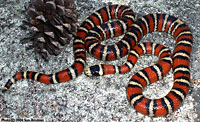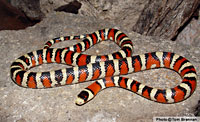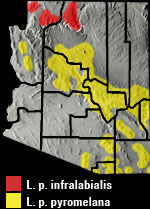Online Field Guide to The Reptiles and Amphibians of Arizona


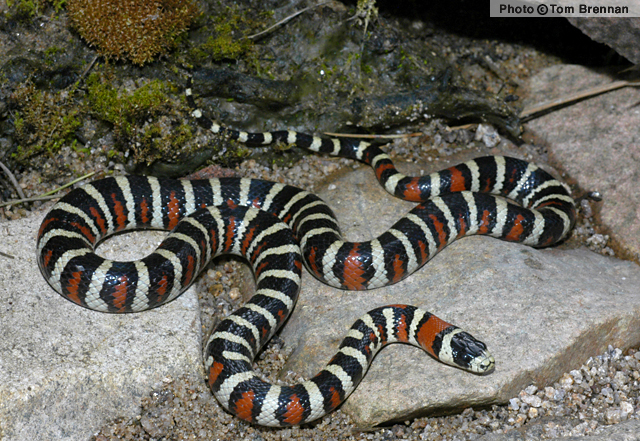
Yavapai County, AZ
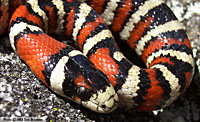 Yavapai Co., AZ |
||
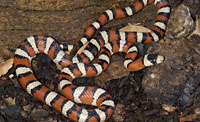 Santa Cruz Co., AZ |
| SONORAN MOUNTAIN KINGSNAKE Lampropeltis pyromelana |
Non-Venomous
|
| DESCRIPTION: A medium-sized (up to 1,088 mm or 43″ in total length) snake with alternating red, black, and white bands. The white bands are bordered by black bands. The black bands become wider mid-dorsally and often merge together at the midline of the back thereby “bridging” across the red bands. The black bands become more narrow on the lower sides and often disappear before reaching the belly. The head is noticeably wider than the neck and the snout is white or cream colored. The pupils are round and the scales are smooth and shiny. Its light colored snout distinguishes this snake from the similar looking Milksnake.
DISTRIBUTION: In Arizona this snake is found at elevations ranging from 3,000′ to 9,000′. Its range extends from the extreme northwestern corner of the state, across the central mountains and Mogollon Rim country, into the “sky island” mountain ranges of southeastern Arizona. HABITAT: This snake occupies communities ranging from Interior Chaparral up through the highest elevations of Petran Montane Conifer Forest. It is often found on heavily wooded, rocky slopes or in steep canyon bottoms with abundant leaf-litter, fallen logs, and rocks. It also inhabits relatively open rolling hills and grasslands in transition zones. DIET: This relatively powerful constrictor preys on lizards, rodents, birds, and bats. REPRODUCTION: Mating takes place in spring and a clutch of up to 9 eggs is laid in late spring or early summer. Hatchlings emerge in late summer. SUBSPECIES FOUND IN AZ: Brennan, T. C., and A. T. Holycross. 2006. A Field Guide to Amphibians and Reptiles in Arizona. Arizona Game and Fish Department. Phoenix, AZ Brennan, T. C., and A. T. Holycross. 2005. A Field Guide to Amphibians and Reptiles of Maricopa County. Arizona Game and Fish Department. Phoenix, AZ Degenhardt, W. G., Painter, C. W., and Price, A. H.. 1996. Amphibians and Reptiles of New Mexico. University of New Mexico Press. Albuquerque. Fowlie. 1965. The Snakes of Arizona. Azul Quinta Press, Fallbrook, California Stebbins. 1985. Western Reptiles and Amphibians. Houghton Mifflin. New York, NY |
|
Visit Partners in Amphibian and Reptile Conservation:


HOME
Copyright © 2023, Arizona Game and Fish Department. All rights reserved.
If you make use of the textual contents of this site in reports, publications, etc. please cite and credit the author(s) and photographer(s). All photos on this website are copyrighted. However, those found in the species account section may be used for any noncommercial scientific, educational, or conservation purposes provided that photographs are not altered and continue to bear the copyright symbol and name of the photographer. Please contact the photographer regarding commercial use of copyrighted photographs.










